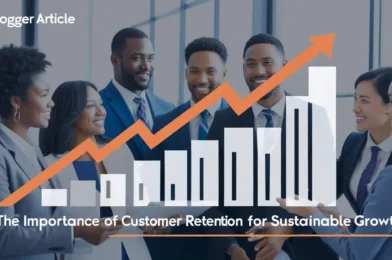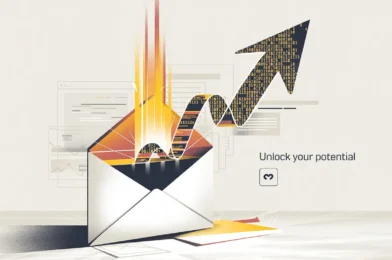How Customer Retention Helps Grow Your Business: The Key to Sustainable Success
In the relentless pursuit of expansion, businesses often fixate on acquiring new customers. While attracting fresh faces is undoubtedly important, there’s a powerful, often underestimated engine for growth hiding in plain sight: your existing customer base. Focusing on customer retention isn’t just about maintaining the status quo; it’s a strategic imperative that can significantly grow your business and lay the foundation for long-term, sustainable success.
Many companies pour vast resources into lead generation and sales funnels, celebrating every new conversion. Yet, they may inadvertently neglect the goldmine they’re already sitting on. Understanding and prioritizing customer retention unlocks a cascade of benefits, from increased profitability to enhanced brand reputation. This article delves into why keeping your current customers happy is paramount and explores actionable strategies to foster loyalty and drive sustainable growth.
Why Focus on Customer Retention? The Undeniable Benefits
Shifting some focus from pure acquisition to retention isn’t about abandoning growth; it’s about growing smarter. The advantages of retaining customers are numerous and directly impact your bottom line and overall business health.
1. Increased Profitability: The Financial Powerhouse
This is perhaps the most compelling reason. Acquiring a new customer can be significantly more expensive than retaining an existing one. Estimates vary, but studies consistently show acquisition costs can be 5 to 25 times higher than retention costs, depending on the industry and specific calculations.
Why the difference?
- Lower Marketing & Sales Costs: You’ve already done the heavy lifting of attracting and converting retained customers. Marketing to them is often cheaper (think targeted email campaigns vs. broad advertising).
- Higher Purchase Frequency & Value: Loyal customers tend to buy more often and spend more over time compared to new customers who might be making a single trial purchase.
- Reduced Price Sensitivity: Happy, loyal customers often focus more on value and relationship than purely on price, making them less likely to defect for a small discount elsewhere.
Furthermore, research by Bain & Company found that increasing customer retention rates by just 5% can increase profits by 25% to 95%. That’s a staggering return on investment.
2. Enhanced Customer Lifetime Value (CLV)
Customer Lifetime Value (CLV) is the total predicted revenue a business expects to earn from a single customer account throughout their entire relationship with the company. Retention is the engine that drives CLV upwards.
Every time a customer makes a repeat purchase, their CLV increases. Loyal customers:
- Buy Repeatedly: The core of CLV.
- Purchase Across Product Lines: They are more likely to trust you enough to try other offerings (cross-selling).
- Upgrade or Buy Premium Versions: Satisfied customers are prime candidates for upselling.
By focusing on keeping customers engaged and satisfied, you directly increase the average CLV, making each customer relationship significantly more valuable over time.
3. Stronger Brand Advocacy and Word-of-Mouth Marketing
Happy customers don’t just stay; they talk. Loyal patrons often become enthusiastic brand advocates, providing powerful (and free) word-of-mouth marketing. In today’s digital age, this translates to:
- Positive Online Reviews: Leaving glowing testimonials on Google, Yelp, or industry-specific sites.
- Social Media Sharing: Posting about their positive experiences, tagging your brand.
- Referrals: Directly recommending your business to friends, family, and colleagues.
Nielsen reports that 92% of consumers trust recommendations from friends and family above all other forms of advertising. Harnessing this trust through customer retention is marketing gold.
4. Valuable Feedback Loop for Improvement
Your existing customers are an invaluable source of honest feedback. They know your product or service intimately – its strengths and weaknesses. Engaging with them provides insights you simply can’t get from prospects.
By actively soliciting and listening to feedback from loyal customers, you can:
- Identify Areas for Improvement: Pinpoint pain points in the customer journey or product flaws.
- Generate New Ideas: Discover unmet needs or potential new features/services.
- Validate Business Decisions: Test ideas or concepts with a receptive audience before a wider launch.
This continuous feedback loop helps you refine your offerings and operations, making your business stronger and more customer-centric.
5. Greater Resilience and Stability
A business overly reliant on constantly acquiring new customers operates on a treadmill. Market fluctuations, increased competition, or changes in advertising costs can severely impact lead flow and growth.
A strong base of loyal, repeat customers provides stability and resilience. This recurring revenue stream makes your business less vulnerable to external shocks and provides a more predictable financial foundation. During challenging economic times, it’s often the loyal customers who stick around, ensuring business continuity.
Strategies for Boosting Customer Retention
Understanding the ‘why’ is crucial, but the ‘how’ is where the magic happens. Implementing effective customer retention strategies requires a deliberate and ongoing effort across your organization.
1. Provide Exceptional Customer Service
This is non-negotiable. Poor customer service is one of the fastest ways to drive customers away. Exceptional service, conversely, builds trust and loyalty.
- Be Responsive: Address inquiries and issues promptly across all channels (phone, email, social media, chat).
- Be Empathetic: Understand customer frustrations and strive to find helpful solutions. Train your team in empathy and active listening.
- Go the Extra Mile: Sometimes a small, unexpected gesture can turn a neutral or negative experience into a positive one.
- Empower Your Team: Give your front-line staff the authority to resolve common issues without excessive escalation.
Excellent service makes customers feel valued and supported, making them far more likely to stay.
2. Implement a Loyalty Program
Rewarding customers for their repeat business is a direct way to encourage loyalty. Loyalty programs can take various forms:
- Points Systems: Customers earn points for purchases, redeemable for discounts or rewards.
- Tiered Programs: Offer increasing benefits as customers spend more or engage more frequently.
- Exclusive Access: Provide members with early access to sales, new products, or special content.
- Cash Back or Discounts: Offer direct financial incentives for continued patronage.
The key is to make the program simple to understand, easy to use, and genuinely valuable to your target audience.
3. Personalize the Customer Experience
Generic interactions feel impersonal. Customers appreciate being treated as individuals. Leverage customer data (ethically and transparently) to personalize their experience:
- Personalized Recommendations: Suggest products or content based on past behavior and preferences.
- Targeted Communications: Segment your audience for emails and offers relevant to their interests or purchase history. Utilize insights from The Best Content Marketing Tools to help manage and personalize content delivery.
- Remember Key Details: Use CRM data to acknowledge past interactions or preferences (e.g., birthdays, previous support issues).
Personalization shows customers you understand and value them beyond their transaction history.
4. Engage Through Multiple Channels
Stay top-of-mind by engaging customers where they are. This doesn’t mean bombarding them, but rather providing value consistently across relevant platforms.
- Email Marketing: Send newsletters, targeted promotions, valuable content, and personalized updates. Optimizing these campaigns is crucial; learn more with these Powerful Email Campaign Optimization Strategies.
- Social Media: Build a community, share useful content, run contests, respond to comments and messages promptly.
- Content Marketing: Provide valuable blog posts, guides, webinars, or videos that help your customers succeed or solve their problems. Understand the fundamentals by checking out What is Digital Marketing? A Beginner’s Guide.
- In-App Messaging/SMS: Use for timely notifications, support, or exclusive offers (with permission).
5. Solicit and Act on Feedback
Don’t just wait for customers to complain. Proactively ask for their opinions through surveys (like Net Promoter Score – NPS), feedback forms, or direct outreach.
Crucially: Don’t just collect feedback; act on it. When customers see their suggestions lead to tangible improvements, it reinforces their connection to your brand and shows their voice matters. Close the loop by informing customers about changes made based on their input.
6. Offer Exclusive Content or Early Access
Make your loyal customers feel special by granting them exclusive perks. This could include:
- Early access to new product launches.
- Invitations to beta testing programs.
- Access to premium content (webinars, reports, tutorials).
- Member-only sales or discounts.
Exclusivity fosters a sense of belonging and rewards customers for their ongoing commitment.
Need Help Implementing These Strategies?
Implementing sophisticated personalization, engaging email campaigns, or managing social media effectively requires expertise. If you need skilled professionals to design loyalty programs, craft compelling emails, manage your social presence, or handle customer service tech setup, many businesses find the talent they need to make them happy on freelance platforms. You can explore a wide range of skilled freelancers specializing in marketing and customer service on Fiverr.
Measuring Your Customer Retention Success
You can’t improve what you don’t measure. Tracking key metrics is essential to understand how well your retention strategies are working and identify areas for improvement.
Key Metrics to Track:
- Customer Retention Rate (CRR): The percentage of customers who remain customers over a specific period. Formula: `((Number of Customers at End of Period – Number of New Customers Acquired) / Number of Customers at Start of Period) * 100`.
- Customer Churn Rate: The percentage of customers who stop doing business with you over a specific period. It’s the inverse of CRR (Churn Rate = 1 – CRR).
- Customer Lifetime Value (CLV): As discussed earlier, tracking the average CLV helps gauge the long-term value generated by your retention efforts.
- Net Promoter Score (NPS): Measures customer loyalty and satisfaction by asking how likely customers are to recommend your business. Learn more about calculating NPS here.
- Repeat Purchase Rate: The percentage of customers who have made more than one purchase.
Tools and Techniques for Measurement:
Utilize tools like your Customer Relationship Management (CRM) system, analytics platforms (e.g., Google Analytics), and specialized customer feedback tools (e.g., SurveyMonkey, Delighted) to gather and analyze this data effectively. Regularly review these metrics to assess performance and refine your strategies.
Conclusion: Retention is the Bedrock of Sustainable Growth
In the quest to grow your business, never underestimate the immense power of your existing customer base. While acquisition opens the door, retention builds the house – a stable, profitable, and resilient enterprise.
By focusing on delivering exceptional experiences, personalizing interactions, rewarding loyalty, and actively listening to your customers, you transform satisfied buyers into loyal advocates. This shift not only boosts profitability through lower costs and higher CLV but also strengthens your brand, provides invaluable feedback, and creates a foundation for truly sustainable success.
Stop thinking of retention as merely “keeping” customers; start viewing it as actively cultivating your most valuable asset. The rewards – both financial and strategic – are simply too significant to ignore.
Ready to Grow Your Business Through Better Retention?
Take action today! Review your current customer retention efforts. Identify one strategy from this article that you can start implementing or improving this week. Whether it’s enhancing your customer service protocols, planning a simple loyalty program, or setting up a system for collecting feedback, the journey to sustainable growth starts with valuing the customers you already have.

